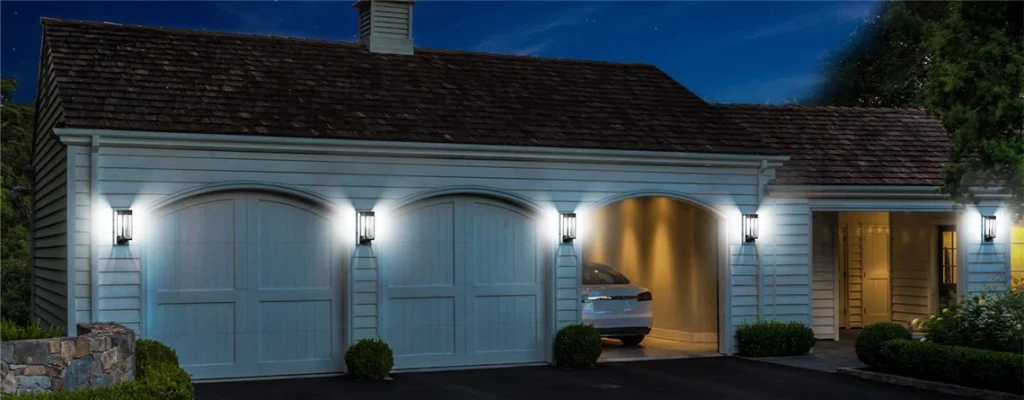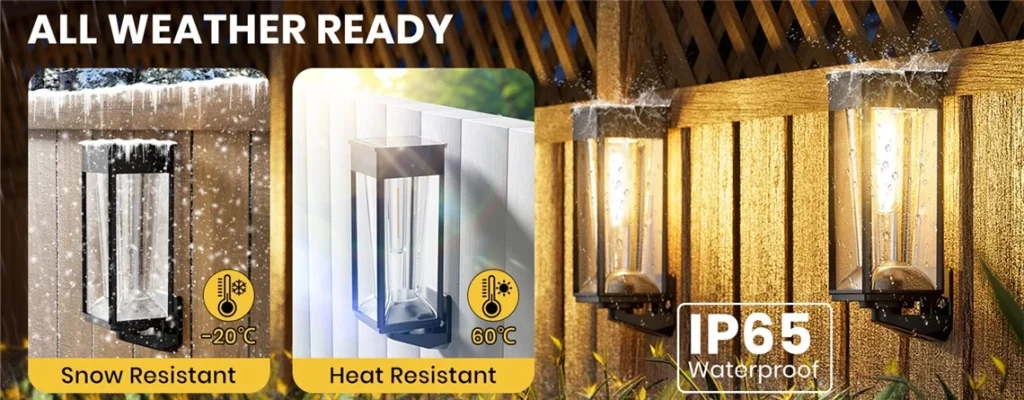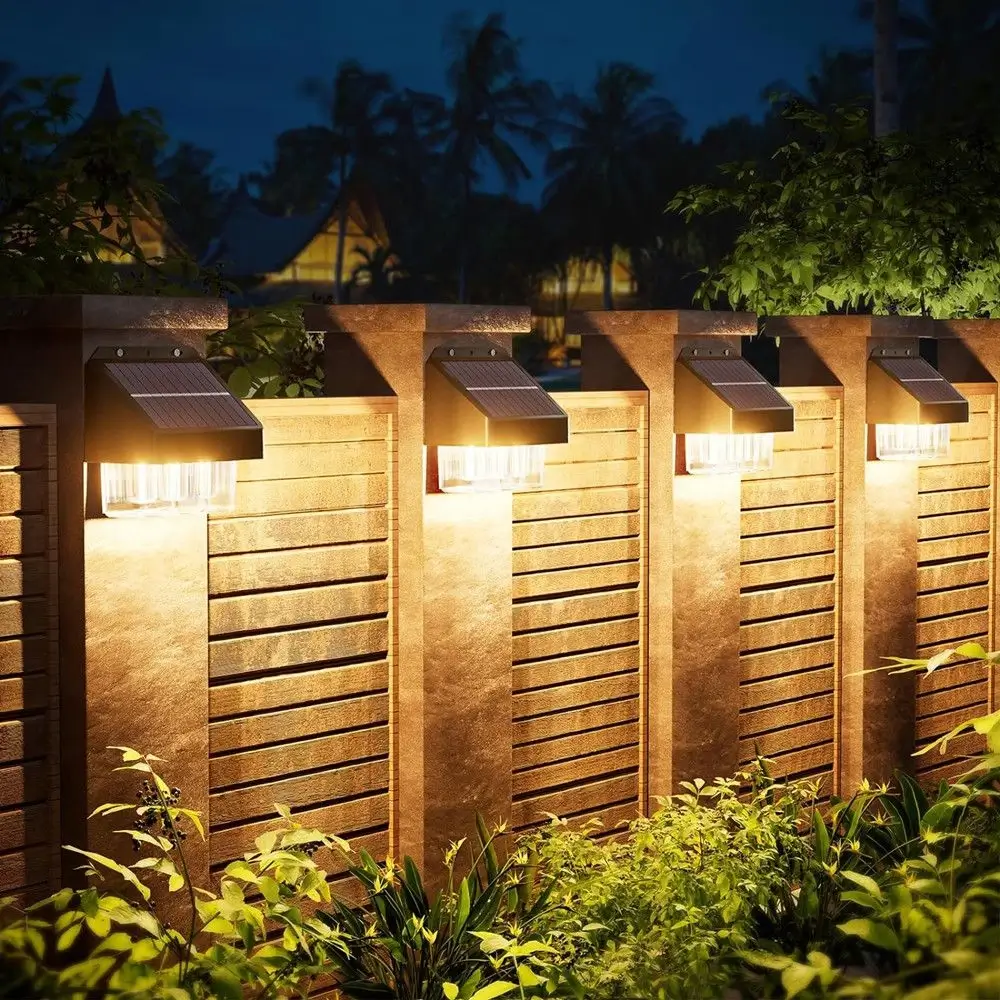Outdoor solar lights wall mounted are a game-changer for American homeowners looking to enhance their outdoor spaces, from charming porches in Georgia to sturdy fences in Colorado. These eco-friendly, wire-free lights combine solar power with versatile wall-mounted designs, offering both functionality and aesthetic appeal without the hassle of electrical wiring. Whether you’re lighting up a cozy entryway in Maine or securing a backyard in Texas, understanding their scene-specific value, selection criteria, installation techniques, performance in different settings, and potential for functional expansion will help you maximize their benefits. This guide is tailored for U.S. users, providing practical insights to make your outdoor solar lights wall mounted shine.

Scene-Specific Value of Wall-Mounted Solar Lights
Outdoor solar lights wall mounted excel in leveraging vertical space and providing targeted illumination, making them ideal for various outdoor settings.
Vertical Space Lighting for Diverse Applications
These lights are perfect for illuminating vertical surfaces like porches, fences, or eaves. On a front porch in suburban Virginia, they highlight entryways, enhancing curb appeal and safety. Along a backyard fence in Arizona, they create a secure perimeter, deterring intruders. Under eaves in rainy Oregon, they offer reliable lighting shielded from the elements. Their ability to mount on walls frees up ground space, making them a versatile choice for compact urban patios in Chicago or sprawling rural properties in Montana.
Localized Lighting in No-Main-Light Environments
In areas lacking overhead lighting, outdoor solar lights wall mounted provide focused illumination. For example, a porch in Florida without a ceiling fixture benefits from wall-mounted lights that brighten key areas like doorways or seating spots. They’re also ideal for sheds or garages in rural Wisconsin, where running electrical lines is impractical. By delivering targeted light, these fixtures enhance functionality and ambiance without relying on a main power source.
Functional Selection: Prioritizing Features for Wall-Mounted Scenes
Choosing the right outdoor solar lights wall mounted involves aligning their features with your specific needs, from sensing modes to light quality and structural compatibility.
Sensing Modes for Scene-Specific Needs
Different modes cater to various scenarios:
- Motion Sensing: Ideal for security on a California driveway, motion-activated lights turn on when someone approaches, saving energy. Brands like Ring offer adjustable sensitivity for busy areas.
- Dusk-to-Dawn: Perfect for constant illumination on a Minnesota porch, these lights activate at nightfall and stay on until dawn, ensuring consistent lighting.
- Always-On Mode: For decorative purposes in a Texas backyard, some models offer a low-brightness constant glow, enhancing ambiance during gatherings.
Choose a model with multiple modes for flexibility across seasons and uses.
Light Modes and Ambiance Matching
The light’s color and intensity shape the mood:
- Warm Light (2700-3000K): Creates a cozy feel for social spaces like a New York patio.
- Cool Light (5000-6000K): Offers crisp visibility for security-focused areas like a Colorado fence line.
- Adjustable Brightness: Dimmable lights, common in brands like Aootek, let you tailor intensity for different settings, from bright task lighting to soft accent glows.
Match the light mode to your deck’s purpose for optimal effect.
Installation Load and Wall Compatibility
Wall-mounted lights must suit the mounting surface. Lightweight plastic models work for wooden or vinyl siding on a Georgia home, while heavier metal units require sturdy brick or concrete walls, common in older homes in Massachusetts. Check the light’s weight (typically 1-3 lbs) and ensure your wall can handle it. Use appropriate anchors or screws (available at Home Depot) to secure heavier models, especially in windy areas like Oklahoma.
Installation Techniques: Scene-Specific Wall-Mounting Strategies
Proper installation ensures your outdoor solar lights wall mounted perform reliably across different scenarios.
Porch Area: Aligning with Entryway Flow
For porch lighting, position lights to complement the entry path. In suburban New Jersey, mount lights at 6-8 feet high near the door to illuminate steps and keyholes without glare. Angle the light downward to focus on the walkway, ensuring safe navigation. Place the solar panel on a nearby wall or roof edge with clear sun exposure, critical in cloudy regions like Washington.
Fence Area: Planning for Multi-Light Coordination
Along fences, spacing is key. In a Texas backyard, install lights every 6-10 feet to ensure even coverage without dark spots. Use motion-sensing models for security, syncing multiple lights for seamless activation. Ensure panels are unobstructed by nearby structures or trees, a common issue in leafy North Carolina. Test the setup at night to confirm no gaps in illumination.
Older Walls: Reinforcing for Stability
Older walls, like those on historic homes in Boston, may crumble or have weak spots. Use masonry anchors or toggle bolts for brick or concrete, and check for rot in wooden siding before mounting. In coastal Maine, where salt air accelerates corrosion, opt for stainless steel screws and apply sealant around mounts to prevent water ingress.

Scene Performance: Analyzing Strengths and Weaknesses
Each installation scenario has unique advantages and challenges, impacting how outdoor solar lights wall mounted perform.
Porch Scene
- Advantages: Enhances entryway safety and convenience, especially with motion sensors that activate as you approach. Ideal for welcoming guests in Florida.
- Disadvantages: Light may be blocked by door frames or porch furniture, reducing coverage. Installation height is often limited by wall space, requiring careful positioning.
Fence Scene
- Advantages: Covers large areas, perfect for security along a California property line. Multi-light setups create a cohesive barrier, deterring intruders.
- Disadvantages: Corners may have blind spots, requiring additional lights. Prolonged exposure to rain in Seattle tests waterproofing, so high IP ratings (e.g., IP65) are essential.
Eaves Scene
- Advantages: Eaves protect lights from rain and sun, extending lifespan in humid Louisiana. Stable mounting ensures consistent light angles.
- Disadvantages: Solar panels under eaves may collect dust or debris, reducing efficiency in dusty Arizona. Winter sunlight shortages in Minnesota can limit charging.
Functional Expansion: Extending the Role of Wall-Mounted Lights
Outdoor solar lights wall mounted offer exciting possibilities beyond basic lighting, enhancing their value for American homeowners.
- Smart Integration: Pair lights with smart home systems like Amazon Alexa or Google Home, available with brands like Philips Hue. Control brightness or schedules remotely, ideal for urban homes in Chicago.
- Color-Changing Options: RGB models add festive flair for holidays, like Christmas in Colorado or Halloween in Oregon, transforming your porch or fence into a vibrant display.
- Security Enhancements: Combine with cameras or alarms for a robust security setup, popular in rural Texas where properties are spread out. Motion-triggered lights can alert you to activity via smartphone apps.
- Pathway Extension: Use extension cables to link wall-mounted lights with ground or step lights, creating a cohesive lighting scheme for multi-level decks in California.
These expansions make your lights more versatile, adapting to evolving needs.
Conclusion
Outdoor solar lights wall mounted are a stylish, sustainable solution for illuminating porches, fences, and eaves across American homes. Their wire-free design, versatile sensing modes, and customizable light settings make them ideal for diverse scenarios, from enhancing safety in Georgia to adding ambiance in Texas. By choosing the right features, installing them strategically, understanding their scene-specific performance, and exploring functional expansions, you can maximize their value. With proper care, these lights will brighten your outdoor spaces reliably, blending eco-friendly technology with practical elegance.


Leave a Reply